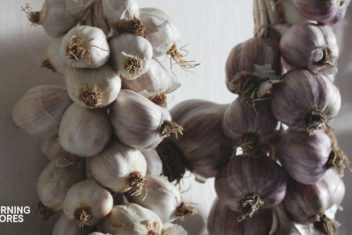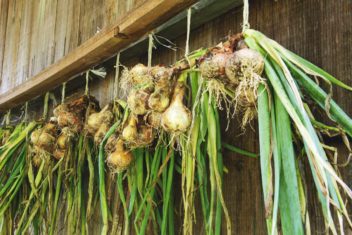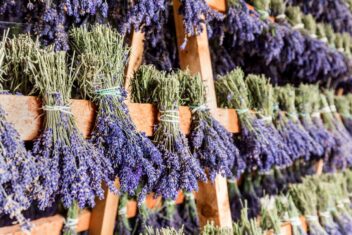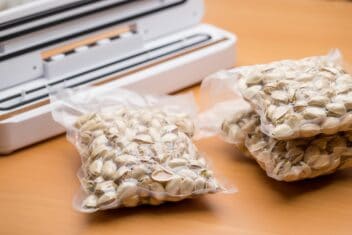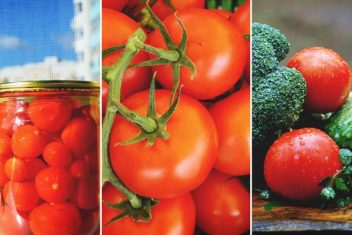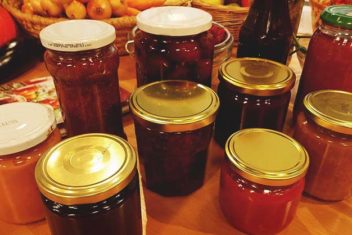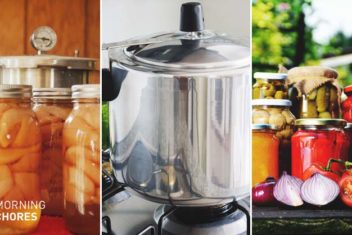If you’re fortunate enough to have a large parcel of land, you can build yourself a good old-fashioned root cellar to store food for the winter. For those of us who have smaller yards or irregular land to work with, we need to sort out some root cellar alternatives to see us through.
I have used several of these techniques to good effect, though some are better suited to certain climates than others.
Fortunately, whether you’re living in a temperate zone, or a place that gets several months of cold and deep snow, there’s an option that’s just perfect for your needs.
1. Sunken Fridges or Freezers

Countless refrigerators and chest freezers end up in landfill sites every year when they can’t be repaired anymore. If yours happens to give up the ghost, upcycle it into one of these handy root cellar alternatives.
This option is best for people who have a fair bit of land to play with. Basically, you measure out an area that’s just a bit bigger than your fridge or freezer turned on its side, with the door on the top.
Dig a hole that’s about 10 inches deeper than the fridge/freezer depth, and get a couple of friends to help lower the appliance into the hole.
Then, put down a layer of straw, sand, or sawdust inside and add your produce. Make sure to space the items out well so air can circulate between them. Alternatively, if you have many small items (like small apples, etc.), you can store them in burlap sacks and place those in the sunken freezer.
Since these are so well insulated, you can use these in climates that fluctuate a fair bit over the winter. They’ll keep the temperature inside fairly even and will also prevent external moisture from seeping in.
2. Buried Cooler Chests

If you’re looking for a more cost-effective alternative for the method above, check out this technique. Do you know those standard, 50-quart, insulated coolers that you can pack full of food to take camping?
They’re about $20-50 each and just happen to be absolutely perfect for storing food for winter.
These are ideal if you don’t have enough outdoor space to sink a fridge or freezer. I like this method because most of my land is on solid rock (hello Canadian shield!), but I can sink several of these into the sandy incline behind my house.
Layer root vegetables and hardy produce like apples and cabbages into the same mediums above. Then bury those chests under at least six inches of soil.
These little root cellar alternatives are also good for climates that fluctuate a little bit. Just be sure to check them if there’s a surprise thaw in January. The last thing you want is for your hard-won produce to rot before you and your family can eat it.
3. Trash Can Cellars
These follow the same idea as the coolers above, but in super-cheap 20-gallon plastic or metal trash cans. This option is actually better in areas that get very cold winters, as they’re made of thin material without any insulation.
Basically, they’re best sunken into the soil that isn’t likely to thaw and then refreeze several times over.
Despite the fact that I eschew plastic in just about every other aspect of my life, I actually recommend that material versus metal for this purpose. Metal trash cans will rust fairly quickly, which isn’t ideal if you’d like to reuse these sunken mini root cellars for several years.

Plastic, as you know, lasts for a really long time. It also isn’t terribly affected by temperature fluctuations.
Just make sure to poke a few holes at the bottoms of your cans, regardless of the material they’re made of. This will allow any condensation to seep out the bottom and into the soil, so your produce won’t get soggy bottoms.
Store produce in these the same way that you would in the insulated coolers listed above. Sand, straw, and sawdust are all great for keeping humidity even, and space items out so they don’t rot each other in storage.
4. Sunken Clay Pots

As far as root cellar alternatives go, this one’s very cheap. That said, it’s only suited to storing small amounts of food, in tiny outdoor spaces.
Basically, you use a similar technique to above, only using terracotta pots. It’s perfect for storing things like apples, Brussels sprouts, and smaller root vegetables.
You layer the items in the storage mediums mentioned above, inside terracotta pots. Get yourself pot bases that are slightly larger than the pots themselves, so you can flip them over and use them as lids. Bury these outside in your yard, and enjoy your homegrown produce all winter long.
Note that these pots are also better for climates that don’t fluctuate in temperature too much during the cold season. Terracotta is gorgeous but can shatter easily if it goes through too many hot/cold waves.
As a bonus, these pots can pull double duty. Once they’ve been emptied at the end of the season, clean them well, fill them with potting soil and use them to grow more food. You can even use the aforementioned trash cans to grow tons of potatoes or sweet potatoes too.
Isn’t creative homesteading fun?
5. Basement or Garage Storage

Do you have an unfinished basement? Or maybe some extra space in your garage? Then don’t let it go to waste. Pack your produce into cardboard boxes or wooden crates, and store these on shelving units.
Since this is an aboveground option, your produce won’t have the same insulation protection as the buried techniques mentioned above. That said, if you live in an area like mine that stays cold for months, you won’t have to worry about damage from thawing and re-freezing.
Another benefit of this technique is that it’s a lot easier to access stored food when it isn’t buried in the ground. You won’t have to dig through snow to get to your bounty: you can just take a box off the shelf and root through it. (See what I did there? Roots… hahah.)
What Not to Store in Root Cellar Alternatives
Now, proper root cellars are perfect for storing just about anything. They might have the word “root” in their title, but people store everything from home-canned preserves to ceramic sauerkraut crocks in them.
These low-cost alternatives aren’t quite as versatile, nor can they store quite the same items. There’s a lot more space in a standard root cellar, and strong shelves can support jars, cans, crocks, and more.
Sunken root cellar alternatives can get a lot colder than regular ones, especially if you’re using materials that aren’t well insulated. As a result, glass jars full of preserves, soups, or pickles can shatter. This doesn’t just waste good food but undoes a ton of hard work while contaminating everything else in the container.
Stick to root vegetables and thick-skinned produce, and you should be fine.
Remember to Use Markers!
Every spring, little oak tree seedlings pop up all over my land. Do you know why? Because squirrels bury acorns pretty much everywhere and then either forget where they’ve stashed the darned things or can’t find them beneath several feet of snow.
These root cellar alternatives are intended to make our lives a bit easier—giving us extra space to store food for wintertime. They aren’t going to be much help if we can’t find them in the middle of February!
If your area doesn’t get much snow or large animal activity, then you can stick a metal plant marker near the sunken cellar with a bright ribbon hung on it.
Alternatively, if you’ll need to dig out your produce from under a few feet of snow, plant a tall wooden or metal spike into the ground beside the container with a bright flag on it. (Remember whether you’ve planted it to the left or right, so you don’t spend hours digging over an empty space.)

